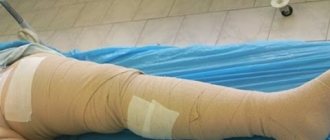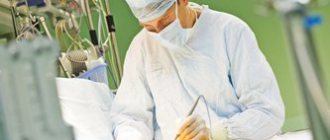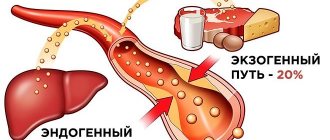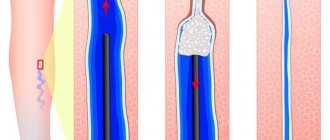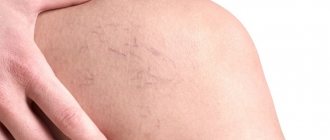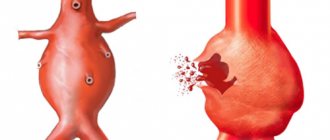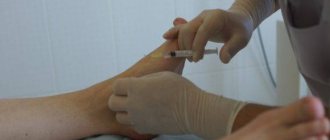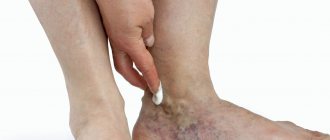Varicose veins (VV) is a well-known disease that can affect both men and women equally. When the first symptoms appear, many do not attach any importance to them, but as the disease develops, they will become more pronounced and will be a constant concern.
Once a diagnosis of varicose veins of the lower extremities is made, surgery is not always performed. There are a number of contraindications and indications for this procedure. We will look at how to cure varicose veins and avoid the consequences below.
An example of the development of VRV
Types of operations
The general name for surgery to remove diseased veins is phlebectomy. Modern types of this procedure:
- Carrying out a stripping procedure (long or short) is the most gentle technique, during which the doctor can remove only a certain part of the affected vein. The procedure is performed through a small incision along the vein.
- Laser phlebectomy is a modern treatment method that involves the use of a laser. Thanks to this instrument, the process of laser coagulation occurs inside the affected vessels. The procedure is performed under local anesthesia and does not require the use of special surgical instruments. The laser is injected into a vein along with a small-diameter catheter; then, under the influence of the pulse, small steam bubbles are formed, which affect the walls of the blood vessels. As a result, the affected vein becomes part of the tissue and no longer bothers the patient.
- Endoscopic excision of the affected vein. In this case, an endoscope is inserted into the vein area, and the doctor can personally analyze its condition and the extent of damage. In the future, the surgeon has the opportunity to cut off the affected area.
So-called sutureless technologies are very popular, when the affected area of the vein is excised through small pinpoint incisions. Already 4-6 hours after the manipulations, the patient can walk independently. In the event that the development of trophic disorders is observed, then endoscopic equipment is used.
Short creaking
For varicose veins, this is the most gentle treatment method, thanks to which it is possible to eliminate the affected segment. Before performing the operation, it is necessary to determine with 100% accuracy where the affected vein is located, as well as the length of the segment. Two small incisions are made, after which the affected node is removed.
The rehabilitation period takes a minimum of time, and there is little trauma.
Radiofrequency obliteration
Modern equipment makes it possible to penetrate into the walls of blood vessels with the greatest precision. Catheters are disposable, it is necessary to control the temperature of heating and removal. The patient practically does not feel pain.
Among the advantages are the following:
- you can solve all problems simultaneously on both legs;
- reconstruction of the vein is carried out;
- from an aesthetic point of view, it is possible to achieve a good result.
Due to the many benefits, many people prefer to use this method of treatment.
Endoscopic vein dissection
To perform the operation, a special device is used - an endoscope. You can get complete information about the internal state of the vein. The peculiarity of the therapy is that new technologies are used, they are introduced into the vein remotely.
Laser coagulation
An example of how laser treatment works
Laser surgery for varicose veins is often performed; this method is considered the most minimally traumatic. A light guide is used and inserted into the affected area using an ultrasound scanner.
The targeted laser beam completely covers the affected vein, after which it stops functioning. The method is considered the most popular all over the world.
Under the action of a laser beam, the affected area is glued together. The effect can be carried out in an outpatient clinic, lasting no more than 45 minutes, no incisions are required. If, for medical reasons, classical treatment methods cannot be used, laser treatment is chosen. Thus, you can completely get rid of varicose veins.
The advantages of this treatment are as follows:
- expansion syndrome disappears;
- symptoms of venous insufficiency are removed forever;
- Treatment can be carried out in an outpatient clinic;
- minimal injury;
- the procedure does not last long;
- local anesthesia is used;
- After the intervention, you can go home within a few hours;
- there is no need to adhere to the rehabilitation period;
- no complications arise.
But, despite so many advantages, there are also contraindications for which intervention cannot be carried out:
- blood clotting is poor;
- predisposition to blood clots;
- the lower limbs are prone to fullness, as a result of which it is impossible to wear compression garments;
- andoarteritis.
Overall, this is a safe and effective procedure that allows you to achieve good results.
Possible complications
Crossectomy
The term “crossectomy” means ligation and subsequent intersection of the small or large saphenous vein. As an independent operation, such a procedure can only be carried out in emergency cases when there is a risk of spreading an acute form of thrombosis.
Today, there are more gentle alternative procedures for crossectomy - endovasal laser obliteration and radiofrequency ablation.
The advantages of the methods are: the possibility of avoiding general anesthesia, outpatient treatment, and the absence of cosmetic defects in the form of scars from incisions and scars.
Disadvantages include a higher likelihood of disease recurrence and the fairly high cost of these procedures.
What to do if surgery is contraindicated for you
If for some reason you cannot have surgery, treatment of varicose veins is carried out using conservative methods. The initial stages of the disease can be treated as follows:
- Thanks to compression garments, bulging blood vessels can be maintained in tone. To choose the right compression, you need to consult a doctor;
- You can make lotions for sore areas of the legs from yogurt and wormwood decoction. A compress made from hop infusion, alcohol tincture from Kalanchoe leaves, cabbage with honey or raw potatoes will also be useful;
- The early stage of varicose veins is treated with hirudotherapy. For treatment, leech saliva is used, which thins the blood and helps it circulate better through the veins. But, after this type of therapy, sometimes small scars remain on the skin;
- To treat the disease, lotions, masks or baths are also made from blue clay;
- After consultation with a doctor, varicose veins of the legs can be treated with special pharmaceutical ointments, creams, patches, gels or tablets.
The described conservative methods can be used only in the initial stages of the disease. If varicose veins have acquired a severe form of manifestation, then surgery cannot be avoided. Therefore, it is important to consult a doctor in a timely manner to protect the health of your legs.
Preparation
Surgery for varicose veins of the lower extremities is carried out after a preliminary examination of the patient and an in-person examination.
The following types of examinations may be prescribed:
- Performing an ultrasound scan of the leg veins.
- General blood analysis.
In the future, the doctor will conduct an oral interview to identify possible contraindications to surgical intervention. A preliminary examination allows you to select the optimal type of surgical procedure or, if necessary, combine several well-known techniques at once.
It is very important that the patient understands how to behave correctly before and after the procedure. Before surgery, it is recommended to refrain from taking medications that contain aspirin due to the risk of bleeding. On the day of surgery, you do not need to prepare particularly carefully for the procedure - you only need to get rid of hair in the area of the operated limb.
Preventive measures
Some people's wounds heal very quickly, while others suffer from the appearance of keloids. For this reason, varicose veins not only need to be removed, but all preventive measures must be taken to avoid undesirable consequences.
After the operation, experts recommend moving and not sitting in one place or lying in bed.
Prevention after surgery is as follows:
- First, slowly bend and straighten your knees. Make circular movements with your feet to increase the speed of venous blood flow;
- When you sleep, make sure that your legs are slightly higher than your torso;
- After a couple of days, begin to actively sit up in bed;
- Place an elastic bandage on your operated leg and begin walking and performing light physical therapy exercises. It is recommended to wear an elastic bandage for three months after surgery.
To prevent the disease from returning, it is important to lead an active lifestyle, perform physical therapy, go to the pool, and eat a healthy and balanced diet.
To avoid the development of varicose veins and removal of varicose veins, you need to exercise, run, walk a lot, swim and attend yoga classes.
If you stand a lot throughout the day, you need to take short breaks every two hours - walk on your heels and then on your toes. To avoid varicose veins during pregnancy, it is recommended to wear special compression stockings or tights.
In what case is surgery needed?
Patients who are wondering whether surgery is necessary for varicose veins of the lower extremities should understand that such a radical method of therapy is necessary in the following cases:
- A rapid progression of the disease, which is accompanied by intense pain.
- Development of varicose thrombophlebitis of 1-4 degrees.
- Feeling of intense heat and burning in the veins.
- Spread of varicose veins above the kneecaps.
- Visible formation of a swollen, aesthetically unattractive vein.
The operation is also indicated for the formation of long-term non-healing trophic disorders (ulcers), for which conservative therapy does not have the proper therapeutic effect.
Sclerosis
Treatment of the pathology of varicose veins involves the administration of a liquid form of medication. Using a micro-injection, a special substance is injected that destroys the walls of the veins from the inside. After the procedure, inflammation can be detected at the injection site, which subsequently heals and the affected vessel sticks together. Today, most clinics use a foam-like substance. Once injected into a blood vessel, the foam expands to fill the diameter of the vessel. The patient must take a horizontal position during the procedure.
A visual diagram of sclerotherapy for varicose veins
Sclerosis does not take more than 30 minutes. Surgical treatment does not require a hospital stay. After the procedure is completed, compression stockings are put on your legs. To restore blood circulation through deep blood vessels and to prevent thrombosis, the doctor recommends that the patient take a walk for 30 minutes. For a month, it is recommended to wear compression garments, which can only be removed from the lower extremities at night. The types of therapeutic knitwear, depending on the degree of compression, are determined by the attending physician.
Sclerotherapy is a highly effective method in the fight against varicose veins of the lower extremities, as confirmed by patient reviews. This treatment is used in almost all cases, except for lesions of large veins whose diameter exceeds 2 cm. In this case, the patient needs laser therapy.
Contraindications and possible consequences
It is imperative to take into account possible contraindications and consequences of surgical intervention.
Surgical intervention cannot be performed if the patient has a history of diseases such as hypertension, disturbances of normal heart rhythm, coronary heart disease, the presence of infectious diseases in the acute stage, dermatological inflammatory diseases in the legs.
The operation should not be performed in late pregnancy, or in elderly patients with weakened immune systems.
Patients should take into account possible complications, as well as the consequences of surgical intervention:
- Impaired sensitivity of the operated limb as a result of damage to nerve endings.
- Intermittent or constant numbness in the ankle area.
- Formation of suppuration.
- Development of bleeding of varying intensity.
- Re-formation of bulging veins in the area above or below post-operative scars.
- Pain syndrome does not bother all patients and occurs if the nerve endings have been affected. Normalization of sensitivity in most cases occurs independently, without the use of any medications.
- Hematomas and bruises at the surgical site may be bothersome. In this case, drugs from the group of anticoagulants for local use may be prescribed. If the patient has very delicate and sensitive skin, then traces of bruises can persist for 1-1.5 months.
- The development of edema may indicate that the patient does not follow the doctor’s instructions, does not observe a rest regime and exposes the body, including the lower extremities, to excessive physical activity.
Strictly adhere to the doctor’s recommendations, this determines how quickly the consequences of the operation will pass
Therefore, before deciding whether to undergo surgery for varicose veins of the legs, you should take into account all possible risk factors: thoroughly weigh the pros and cons. The operation should be performed in cases where the manifestations of the disease bother patients for a long time and significantly worsen the quality of life.
It is also necessary to consult only with experienced and qualified doctors who perform such operations: phlebologists, angiosurgeons.
When is it necessary to remove varicose veins?
A referral for surgery is issued by a phlebologist only after a detailed examination (as a rule, ultrasound duplex scanning is used for diagnosis). Removal of varicose veins is necessary in the following cases:
- in case of blood outflow disorders;
- for trophic skin disorders;
- with extensive varicose veins;
- with acute vascular thrombophlebitis;
- if other methods have proven ineffective.
Phlebectomy is considered a radical method and is used when medications or massages do not help and the disease is rapidly progressing. If there are indications, do not delay treatment.
Before prescribing the procedure, the doctor carefully studies the medical history and conducts a survey for allergies and contraindications. Preparation for surgery includes ultrasound examination of the veins. It makes it possible to see the full picture of the disease before surgery. At this stage, the specialist marks the affected vessels and identifies those veins that need to be removed.
Also, surgery for varicose veins cannot be performed before the patient has undergone blood and urine tests and an electrocardiogram. These studies are necessary for the doctor to be sure that the patient’s health is normal and he will tolerate the operation well. In turn, the patient must inform the specialist about taking medications, if they were previously prescribed to him.
Removal of varicose veins: contraindications
If the deep veins are severely affected and the disease has already reached a severe stage of development, phlebectomy is not performed, since it may threaten human health. Contraindications for the removal of varicose veins include:
- hypertension;
- presence of infections;
- inflammatory processes;
- coronary heart disease.
The operation is also not carried out in late pregnancy. If possible, it is replaced by other methods of treatment or postponed until after childbirth.
How is the operation performed?
Removal of varicose veins is performed under general anesthesia. The time the procedure takes depends on the complexity of the disease. On average it lasts from 1 to 2 hours. During the operation, the affected vessel is ligated at the point of its connection with the deep veins. Next, a special probe is inserted into it and the affected area is pulled out. After the operation, only small scars measuring 4–5 mm remain on the patient’s skin.
Rehabilitation period
Full recovery of the patient after surgery occurs in 1.5–2 months. During this time, he needs to fix his limbs with an elastic bandage or tight bandages. From the second day after the procedure, the patient is allowed to walk. When the stitches are removed, the patient is prescribed water treatments and exercise therapy. In addition, it is mandatory to prescribe venotonic drugs, which prevent the development of complications and also shorten the rehabilitation period.
Complications
As a rule, phlebectomy is well tolerated by patients. Complications after surgery are unlikely, but they do exist. The most common are:
- bleeding on the first day after the intervention;
- hematomas (disappear within 7–10 days);
- rarely - thromboembolism (blockage of arteries).
It is important to know that surgery to remove varicose veins does not exclude the development of relapse. If preventive measures and doctor's recommendations are not followed, the patient may develop the disease again.
Price for surgery to remove varicose veins
The cost of phlebectomy is calculated for each patient individually, based on the number of affected vessels and the characteristics of the body. The operation, which is carried out in many medical institutions in the capital, remains quite affordable. Moreover, it is considered one of the most effective methods. The price of varicose vein surgery will be affected by:
- clinic class;
- its location;
- surgeon's qualifications;
- the need for additional procedures or studies.
Our specialists
Surgical technique
The peculiarities of the course of varicose veins are that it is impossible to restore the functions of the affected areas of the veins with the help of pharmaceuticals and conservative treatment. Medicines can stop the further development of varicose veins, however, in some cases, operations to remove diseased veins, including the use of a laser, become necessary to maintain the patient’s health and performance.
Rehabilitation period
After the operation, the patient is recommended to follow all the instructions of the attending physician so that the recovery period takes as little time as possible and you can quickly return to your normal lifestyle. During the first 48 hours, patients are strictly prohibited from:
- Drinking alcoholic beverages.
- Motor transport management.
- Bathing in a hot bath.
- Excessive physical activity.
In the first few days after surgery, there may be complaints of pain in the legs, as well as an increase in body temperature. In this case, drug therapy methods are used and physiotherapy is prescribed. The patient should not constantly remain in a horizontal position. You should walk a little every day to restore blood flow.
How is varicose vein surgery performed?
An operation to get rid of varicose veins in the legs should eliminate reflux (backflow of venous blood). Using modern techniques at every stage, even combined phlebectomy today is performed in a one-day hospital, that is, the patient is discharged home the next day after the operation. In this case, general anesthesia is not required. If extensive surgery is being performed, the patient is given general anesthesia or spinal anesthesia (only the lower part of the body is numbed). Hospital stay is 1–2 weeks.
In the first stage, the saphenous vein is removed from the bloodstream by ligating it or cutting it at the junction with the deep vein. Depending on the location of the affected area, an incision is made in the groin area or in the popliteal fossa. Crossectomy can be replaced with laser coagulation.
After crossing the saphenous vein, it is removed. Usually limited to the femoral area (short stripping), because it is most often the one that suffers. Removal with a Babcock probe is considered the most reliable method. To do this, another incision is made in the area of the ankle or upper leg. A probe with a cutting tool at the end is launched through one of the holes and pulled out through the second. The end of the vein is attached to the instrument and it is removed. More gentle techniques are intussusception and PIN stripping. The end of the diseased vein is simply attached with a thread to the wall of the vessel, and the surgeon pulls it out, turning it inside out.
The next stage of the operation is ligation of the perforating veins. If there are few of them and there is access to them, then the muscle fascia is not cut. This allows you to avoid visible cosmetic defects. If the lesion is multiple, the doctor is forced to dissect the muscles, which gives a more lasting result. The use of endoscopic venectomy makes the operation less traumatic, but it is not performed in all clinics, as it requires complex, expensive equipment.
The combined operation is completed by a miniphlebectomy, which allows the removal of visible deformed vessels. Following the marks on the skin, the surgeon removes small veins through small punctures. The operation ends with sutures and an elastic bandage.
Cost of the operation
Phlebectomy is performed both in public clinics and in plastic surgery centers, the purpose of which is to eliminate aesthetic imperfections.
Patients are interested in how much surgery for varicose veins costs.
It all depends on the clinic and the qualifications of the doctor who performs the procedure, as well as on the degree of development of the disease and the complexity of the proposed operation. Not the least place in pricing is given to the city and region in which the patient intends to carry out the procedure.
A number of clinics include a preoperative examination, as well as a rehabilitation period, in the cost. The cost of the procedure ranges from 13,000 to 40,000 rubles.
Combined phlebectomy is the most common method of vein removal
Most phlebologists in state and municipal hospitals perform phlebectomy as the only possible treatment - a surgical operation during which the vein affected by varicose veins is completely removed. The intervention lasts from one to two hours; dilated veins with blood reflux and valve dysfunction are subject to removal.
Before the operation begins, a vein to be removed is marked on the legs of the standing patient. The intervention takes place under general or spinal anesthesia. The first step is usually ligation (ligation) and division of the great saphenous vein at the point of its confluence with the femoral vein, after which the saphenous vein is actually removed. To do this, the surgeon performing the operation for varicose veins makes two small incisions at the beginning (groin area) and at the end (ankle area) of the removed area, then a probe is inserted into the lumen of the vein, and the vein attached to it is removed from under the skin. If necessary, the dilated tributaries of the great saphenous vein are removed in the same way.
The recovery period after combined phlebectomy (removal of veins) depends on the degree of development of the disease, the general condition of the patient and other factors. Patients after such an operation usually stay in the inpatient department for 7–10 days, after which, in the absence of complications, they are discharged and spend the rest of the rehabilitation period (up to 1 month) at home.
The most severe complication of the postoperative period is thrombophlebitis, and in the worst case, pulmonary embolism. To avoid this, various measures are used: compression therapy, medications that reduce the risk of thrombosis, early activation of the patient, etc. The most common complications after surgery to remove varicose veins are the formation of extensive bruises along the vein, tissue swelling and the formation of lumps under the skin , which can persist for several weeks. After the incisions heal, scars may remain, the size of which depends on the characteristics of the patient’s body. The total time of incapacity for work lasts from one to three months.
Forecasts from experts
The combined phlebectomy procedure does not exclude the possibility of repeated recurrence of the disease. After using radical treatment methods, recurrence of varicose veins is possible due to the physiological characteristics of the body (the structure of blood vessels and veins), or a violation of the technique of performing the procedure (if the doctor was unable to normalize the patency of the affected vein). The risk of re-exacerbation of the disease is observed in approximately 15-20% of cases. If the patient notices signs of repeated relapse of the disease, you should consult a doctor as soon as possible.
Only an experienced specialist will help you correctly suggest which operation to remove varicose veins to choose, and also give useful recommendations that will need to be followed during the recovery period. If you do not consult a doctor in a timely manner, the consequences can be dire and irreversible.
Reasons for the development of varicose veins
Veins, unlike arteries, have valves; due to their presence, reverse blood flow is impossible. When their work is disrupted, the elasticity of the vein walls decreases, they become thinner and stretch. Neither valves nor vessels can fully perform their functions, reverse blood flow occurs, and blood stagnates. And remember: if you have varicose veins, you may not need surgery.
Thus, a disease called varicose veins develops. There are quite a lot of reasons leading to this.
Hereditary predisposition
In approximately 1/3 of patients, the diagnosis is made precisely because of genetic predisposition.
But it is worth noting that it is not the disease itself that is inherited, but only the special structure of the blood vessels:
- the connective tissue of the vein walls is not fully developed;
- the valves are defective from birth.
Even with a tendency to form varicose veins, they do not always appear, especially if a person leads a healthy lifestyle and monitors his health.
Example of healthy and varicose veins
Hormonal imbalance
The reasons for the development of varicose veins can be varied, but special attention should be paid to hormonal imbalance; it can occur due to the following factors:
- after childbirth or during pregnancy;
- with the onset of menopause or during menstruation;
- taking hormonal drugs.
As a result of the production of female sex hormones, collagen in the walls of the veins is destroyed, as a result their tone decreases.
Inflammation in the pelvic organs
The inflammatory process that develops in the pelvic organs leads to the fact that blood flow in small veins is disrupted. A communication appears between the arteries and veins, the pressure and volume of blood in the veins increases. When the valves expand, their function is disrupted; due to the rapid flow of blood, they cannot withstand, and varicose nodes begin to form. And remember: when a doctor concludes “varicose veins of the lower extremities,” surgery is not always necessary.
Nervous disorders
Thanks to the nerve endings, the vessels are in good shape. If some kind of failure occurs in the regulation of nervous processes, the tone in the veins begins to decrease, and the vessels increase in diameter.
Increased pressure in the veins can occur due to severe physical overload. People whose professions require them to spend a lot of time on their feet can be considered at risk: hairdressers, loaders, teachers.
The disease is in the progressing stage
Is it possible to delay treatment?
VVD causes a person not only physical discomfort, but also moral discomfort, as his quality of life decreases. That is why it is necessary to pay due attention to your health; if symptoms of varicose veins appear, you should promptly seek help from a medical facility. If surgery to remove varicose veins is recommended, it is recommended that you listen to your doctor's advice and have it done as soon as possible.
Despite the fact that there are a huge number of methods in medicine, varicose veins are still considered not completely curable. Unfortunately, patients do not always pay attention to the first symptoms, citing the fact that it is just fatigue. Thus, the disease progresses, enters a chronic stage, and in the future it will not be possible to eliminate it completely.
What happens to the veins as the disease develops?
There are several stages of development of varicose veins; at the first and second, conservative methods are possible; at the third and fourth, surgical intervention cannot be avoided. But in each specific case, the treatment methods are determined by the doctor.
— So, the effectiveness and safety of the laser is greatly exaggerated?
- This is a good method. But it cannot be considered as a panacea for all forms of venous disease. For us, each patient is, first of all, an individual. Only a vascular surgeon can decide which method is suitable for a particular patient. If you have any doubts before starting treatment, you can come to the free seminars of the “School of Varicose Veins” and get answers to all your questions.
— How do they determine the type of disease?
— Competent diagnosis involves completing an individual course of examination, including various laboratory tests and ultrasound examinations. In our clinic, diagnostics are performed using the most modern research methods - in particular, duplex scanning of veins with color Doppler mapping on an expert-class device. This gives the doctor the opportunity to gain a complete understanding of the structure and function of the veins of the lower extremities. Based on the examination results, the optimal treatment method indicated for a particular patient is selected.
— What can be considered the most effective method?
— To this day, the most reliable way to combat varicose veins remains the removal of altered veins. For this purpose, different types of surgical intervention are performed: ligation of incompetent perforating veins, phlebectomy and microphlebectomy, stripping. If necessary, the trophic ulcer is excised. In most cases, surgery involves the use of several techniques, performed simultaneously or in stages. The use of various combinations of methods is based on the characteristics and severity of pathological changes in the venous network. The choice of a specific method of surgical treatment always remains with the specialist.
